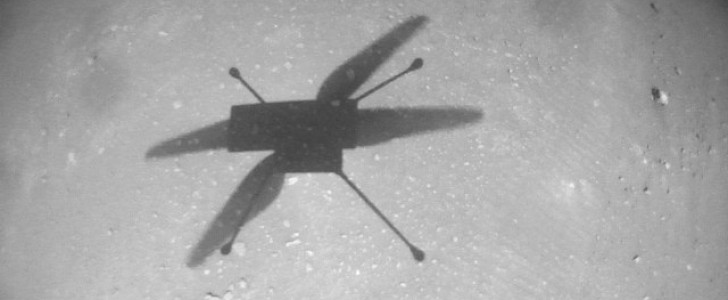For a small aircraft that weighs just a little bit under four lbs (two kgs), NASA's Ingenuity helicopter is a strong fella that continues to impress. The chopper has been grounded for several weeks, waiting for a dust storm to pass. On February 8th, Ingenuity finally took to the Martian skies again, successfully completing Flight 19.
The helicopter was supposed to lift off the Martian soil on January 5th. However, Ingenuity's first flight of 2022 had to be delayed. Our neighbor has powerful winds that can raise small particles accumulated on its surface and cause dust storms. These dust storms can sometimes cross large areas on Mars, leaving the machines that are currently exploring the planet in darkness.
On the first day of the new year, a big dust storm hit the Jezero Crater area, where both the chopper and its rover buddy Perseverance are located. Such an event can pose a serious threat to the solar panels located on Ingenuity since the sunlight can be partially blocked by fine dust particles.
Moreover, the floating dust can also get heated by the Sun and warm up the surrounding atmosphere, causing the already thin air in which the helicopter must fly to become even thinner. Given the circumstances, Ingenuity's team decided to stand down and wait for better weather to resume operations.
It turned out that grounding Ingenuity was the right move. Data recorded by the Mars Environmental Dynamics Analyzer (MEDA) weather station aboard Perseverance during the storm showed a drastic drop in air density, as well as a decrease in the amount of sunlight absorbed by the helicopter's solar arrays.
Unfortunately, Ingenuity had to wait for more than a month until it was able to spin its blades again. But it did it – marking another successful flight. On February 8th, the rotorcraft covered up a 62-meter (203-ft) distance and hovered above the red, cold soil for more than a minute.
On the first day of the new year, a big dust storm hit the Jezero Crater area, where both the chopper and its rover buddy Perseverance are located. Such an event can pose a serious threat to the solar panels located on Ingenuity since the sunlight can be partially blocked by fine dust particles.
Moreover, the floating dust can also get heated by the Sun and warm up the surrounding atmosphere, causing the already thin air in which the helicopter must fly to become even thinner. Given the circumstances, Ingenuity's team decided to stand down and wait for better weather to resume operations.
It turned out that grounding Ingenuity was the right move. Data recorded by the Mars Environmental Dynamics Analyzer (MEDA) weather station aboard Perseverance during the storm showed a drastic drop in air density, as well as a decrease in the amount of sunlight absorbed by the helicopter's solar arrays.
Unfortunately, Ingenuity had to wait for more than a month until it was able to spin its blades again. But it did it – marking another successful flight. On February 8th, the rotorcraft covered up a 62-meter (203-ft) distance and hovered above the red, cold soil for more than a minute.
After some dusty weather delays, it’s time to celebrate the #MarsHelicopter’s first flight of 2022! The rotorcraft flew for the 19th time on the Red Planet, soaring for 99.98 seconds over ~62 meters. pic.twitter.com/akSWkbPuST
— NASA JPL (@NASAJPL) February 8, 2022






